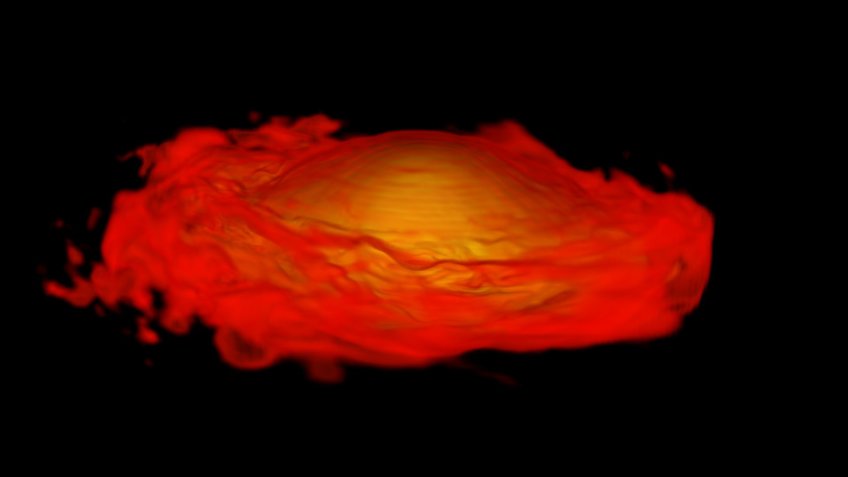
Binary neutron stars: inspiral and merger
When binary neutron stars inspiral and finally merge they emit gravitational waves.
PSR J0737-3039: inspiral and merger
Density profile
The animation and the images show a numerical relativity simulation of two merging neutron stars. For this particular system the stars have 1.34 and 1.25 solar masses. The primary star is a millisecond pulsar with a rotation period of 23 ms. The rotation axis of the primary star and the orbital angular momentum are not aligned which leads to precession effects. The system is constructed based on our knowledge of PSR J0737-3039 and how it will evolve until it merges in about 85 million years.
We show the density profile of the two neutron stars and the hypermassive neutron star formed after the merger of the two stars.
Animation:
Inspiral and merger of a neutron star binary
Images:

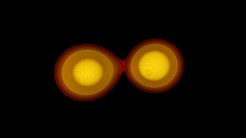
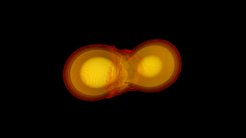

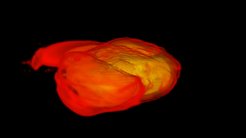
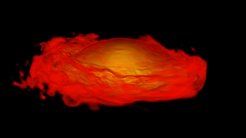
Note: Publication of the images requires proper credits and written permission. Please contact the AEI press office in advance of publication or for higher-resolution versions.
Credit:
T. Dietrich (Friedrich-Schiller-University Jena and Max Planck Institute for Gravitational Physics); BAM collaboration
The BAM collaboration is an international collaboration between the Florida Atlantic University, Friedrich-Schiller-University Jena, Istituto Nazionale di Fisica Nucleare, Max Planck Institute for Gravitational Physics, Università di Parma, Universidade Federal do ABC.
PSR J0737-3039: inspiral and merger
Gravitational wave
The animation and the images show a numerical relativity simulation of two merging neutron stars. For this particular system the stars have 1.34 and 1.25 solar masses. The primary star is a millisecond pulsar with a rotation period of 23 ms. The rotation axis of the primary star and the orbital angular momentum are not aligned which leads to precession effects. The system is constructed based on our knowledge of PSR J0737-3039 and how it will evolve until it merges in about 85 million years.
We show the gravitational wave emitted during the last orbits and the formation of the merger remnant. The gravitational wave has an increasing amplitude and frequency, which is characterized by the color change from blue to green.
Animation:
Inspiral and merger of a neutron star binary
Images:
Volume rendering of the gravitational wave together with density of the two neutron stars.
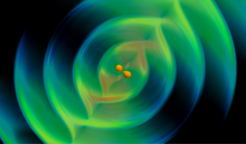
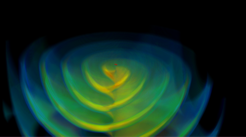
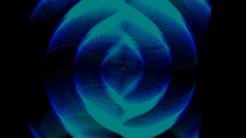
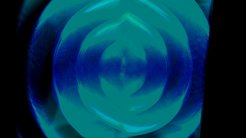
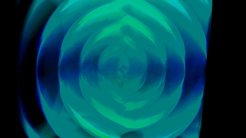
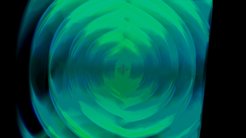
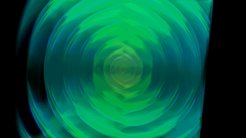
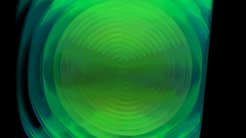
Note: Publication of the images requires proper credits and written permission. Please contact the AEI press office in advance of publication or for higher-resolution versions.
Credit:
T. Dietrich (Friedrich-Schiller-University Jena and Max Planck Institute for Gravitational Physics); BAM collaboration
The BAM collaboration is an international collaboration between the Florida Atlantic University, Friedrich-Schiller-University Jena, Istituto Nazionale di Fisica Nucleare, Max Planck Institute for Gravitational Physics, Università di Parma, Universidade Federal do ABC.
PSR J0737-3039: inspiral and merger
Ejected matter
The short clip shows the merger of two neutron stars with 1.34 and 1.25 solar masses. The blue material is the matter which becomes unbound and leaves the system. The most likely scenario is that ejected matter from neutron star mergers is the main source of heavy elements in the universe.
Inspiral and merger of a neutron star binary
The image shows the material which is ejected during the merger of the two neutron stars.
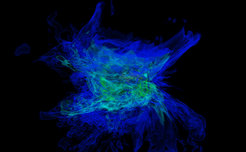
Density, entropy, gravitational wave, and ejected material
The animation is a combination of different movies and shows inspiral and merger of two neutron stars with 1.34 and 1.25 solar masses. The different panels show the density (upper left), the entropy (upper right), the gravitational wave (lower left) and the ejected material (lower right).
In addition to the visualization we add sound. The sound track is generated in a way that we create a sinusoidal sound with the same frequency as the gravitational wave signal and with an amplitude varying proportional to the gravitational wave’s amplitude.
Inspiral and merger of a neutron star binary
Note: Publication of the images requires proper credits and written permission. Please contact the AEI press office in advance of publication or for higher-resolution versions.
Credit:
T. Dietrich (Friedrich-Schiller-University Jena and Max Planck Institute for Gravitational Physics); BAM collaboration
The BAM collaboration is an international collaboration between the Florida Atlantic University, Friedrich-Schiller-University Jena, Istituto Nazionale di Fisica Nucleare, Max Planck Institute for Gravitational Physics, Università di Parma, Universidade Federal do ABC.
High mass ratio binary neutron star merger
This animation shows the density, ejected material, and gravitational waves for a binary neutron star merger consisting of one 1.5 and one 1.0 solar mass neutron star.
Inspiral and merger of a neutron star binary
The different panels refer to: upper left: 2D density profile in the equatorial plane with increasing density from dark blue to dark red; upper right: density profile as shown left together with unbound/ejected material (brown to green); lower left panel: 3D density rendering (yellow) together with the unbound material (blue); lower right: gravitational wave signal (black) and the corresponding frequency (red).
Note: Publication of the images requires proper credits and written permission. Please contact the AEI press office in advance of publication or for higher-resolution versions.
Credit:
T. Dietrich (Friedrich-Schiller-University Jena and Max Planck Institute for Gravitational Physics); BAM collaboration
The BAM collaboration is an international collaboration between the Florida Atlantic University, Friedrich-Schiller-University Jena, Istituto Nazionale di Fisica Nucleare, Max Planck Institute for Gravitational Physics, Università di Parma, Universidade Federal do ABC.































